Legends
If an extraterrastrial astronomer observed our planet from space through a not too powerful telescope, he would hardly notice forming continents, by seeing only water. You see the surface of the seas and oceans makes about 361 300 000 square kilometers, that is more than 70 % percent of a general surface of globe. The recent definition of the Earth as ¨a light-blue planet £ reflects, as a result, indisputable truth. During its long evolution the mankind has confronted ocean very early. This element was attractive, it served as a source of food, but sometimes horrified when it came into the condition of disaster. So, the sea aroused different emotions in the hearts of people. It is reflected in myths, legends and fairy tales. These feelings can be seen in the modern literature and cinema. Sometimes sea charms by its boundlessness, that promises extraordinary adventures, expanding an outlook; and sometimes furious storms or tsunami horrify a person. It excites by secrets hidden for a long period of time in its inaccessible depths. And though due to achievement of modern science we know, for example, that its maximal depth comes nearer to 11 034 meters, we are still far from the complete victory above this element. Permanent accidents show us that sea will hardly turn into a place for rest and relaxation of people soon. Nevertheless we cannot stand the absence of see. There was a sea in the beginning. By last scientific data, there was time when ocean covered almost all our planet. At tops of the highest mountains the geologists still find the mineral rests of sea animals, concerning to prehistorical epoches. According to the standard biological theories, sea is the source of life on the Earth. The amazing fact is that modern scientists, having solid scientific base, repeatedly open what many ancient, so-called primitive peoples intuitively guessed. Most ancient civilizations that are known for us, considered the sea as the mother of the world and people. The ancient Egyptians believed that in the beginning world was only boundless ocean called Noon, in which island has risen gradually. The god of the Sun Ra was born there, and he made all the beings appeared with his help. In Shumer (Mesopothamia) this story was more dramatic: god called Murdook enters severe fight with ocean monster Tiamat and kills him: from the body of this sea goddess he creates the world. The goddess that is expelled from the sky (Athaenthic) tries to be proved on our planet, which was then only boundless ocean. The turtle has substituted the back to her for some time, and she has constructed an island, where she has created other beings. Myths that the life has arisen in sea, exist much in all the parts of the world. There is the same situation with the myths about the flood: all the civilizations and different continents have their own stories about sunk grounds. It is not enough of them in Africa for some reason, but in all other places they are met in various forms and quite often are connected among themselves closely. One of the first written monuments in the history of mankind " The Epos about Guilgamesh
" in Shumer which tells about a flood survived by Uthnapishtim, in many respects is similar to the legend about Noahs Ark. And at the variant of Greeks the angry gods send a flood to the Earth, which was survived by one man called Deucalion. And in Mexican myths the flood lasts for 52 years. Some of these floods do not cover all world, and fall only upon the limited and particularly designated territory, as it is said by numerous Kelt legends. However in most cases this act of nature occurs as a result of the will of the gods and puts the end to the horrible situation usually caused by human anger. Then the mankind revives due to such kind and wise man, as Noy or Deucalion, or such god as Cesalecoatle (¨ feathered snake£) of Mexican atsekes.
Sea gods
In all ancient cultures sea occupies the special place. Set of the gods and supernatural beings is born there. According to the legends of continental Kelts, wizard Marlin and fairy Morgana appeared in the sea, and Dilan Ail Tone (Dilan, son of waves), Valley god; in Greece there was a goddess of love Afrodita appeared from sea foam, and her brother, solar god Apollon was born on Delos island, where sea monsters find a shelter. In Mesopotamian myths one can find Oanness - the huge fish with human head which has left ocean to bring civilization to people.
Kings-dragons are sometimes kind, sometimes angry. In the legends of the Indians of Mexico it was told about great feather dragon Cesalecoatle which has left the sea and has revived mankind destroyed by a flood. He has taught people everything necessary for life and after that has left on east on the raft made of bound snakes. All these myths and legends show the influence of sea on people. Kelts thought that gleams of light on a surface of quiet water as border between two worlds. It is certainly impossible to consider that all these stories reflect, even with exaggerations, any historical realities. In particular, in Breton legends about local floods any real fact (for example, large wave) can be turned into a myth with a set of fantastic details. But the histories about the world accidents are, probably, only poetic reflection of total destruction and following restoration. Something has extremely changed in a society, and people have represented this change as a flood. But, anyway, these myths tell about deep impression that was made on people by destructive power of ocean. Ancient people could not imagine that storm, destroying their houses, sinking the ships, killing people, could be simply natural phenomenon explained by the climatic reasons. They saw expression of evil will or more or less just anger of a powerful god in it. Sea gods and goddesses appear in the majority of mythologies. Greek Poseidon with his trident and crown made of seaweeds , quick-tempered and changeable, have something similar to Japanese god Susano-wo angry and vindictive, originator of earthquakes and tsunami. Scandinavian giant Egir and his severe wife Run are unaccomodating, as well as Maoric Ruacula. Peoples that have thought them up, were not connected in any way with each other, but sea gods are rather touchy and severely punish guilty for disrespect everywhere. However sea gods that are more favourable to people appear in many mythologies. An example is an old Greek man Nerey. His appearance is rather mysterious, for he can change it and he is difficult to catch. However he knows the future and sometimes give this knowledge to the heroes, thus helping them. His fifty daughters, the waves - nereids, can rescue a sailor by bringing them on the shore, but are capable to break the ship. So, ocean gods behave differently. That is why people respect them, being afraid of them at the same time, as gods that are in anger can not only cause storm or natural disaster, but also send sea monsters on the Earth. Strange beings the largest animals of our planet - live in ocean. The whales, cachalots reach weight that is impossible for ground animals. It is rather probable, that it has caused belief in sea monsters, bringing harm to people. In any myth about the sea a huge animal is mentioned usually one eating people and bringing disaster. Sometimes this being can leave sea, attacking a person and sometimes it waits courageous seaman at the bottom of the sea.
Sea animal
Sea monsters, so frequently mentioned in legends, are not just the creations of imagination. Huge and horrifying animals really exist in the oceans. Their appearance makes people become afraid of them, and undeserved reputation is connected to that. For example, myths quite often tell about whales, eating people, though these peaceful animals cannot swallow human being. They eat small fish.
Apart from that, being afraid of sharks is more reasonable. Nevertheless, though some kinds of sharks are aggressive and dangerous, the majority of them is completely harmless. They are even considered gods on Taiti, where they are the patrons of the sailors. The king of Taiti entered sea during coronation ceremony, where sharks had to give him ¨ a sea kiss £. Besides these unfairly blaimed animals, there is one with faultless reputation. This is dolphin, that became famous from Greece up to China as the greatest friend of humanity. There is a set of stories about how dolphins rescued people when their ship wrecked. And though these legends are not supported with any checked up fact, dolphin deserves our sympathy. He is represented as a reptile (snake or dragon) on the pictures. However, even if sea snakes or dragons exist, they never reach those fantastic sizes, which are described in myths. It is quite possible that constant movement of sea influenced the image of sea snake created by the poets of antiquity.
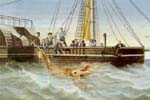
However, almost everywhere sea dragon is considered to be sacred and sometimes becomes an embodiment of absolute evil. The favourite ancient theme of a sea monster is alive in the modern world. The proof to that is huge octopus, described in the novels of Victor Hugo (¨ the Workers of the sea £) and Joule Verne (¨ 20 000 lie under water £),
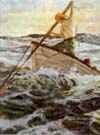
huge white whale Malvilla (¨Moby Dick £) and blood-thirsty shark from rather recent film of ¨Jaw£. Dark fear of our ancestors before ocean stays in our souls. But sea has a lot of more dangerous and serious threats. A sudden attack of a monster, horrifies as well as suddenly burst storm, but a person beforehand expects these dangers and resists to them
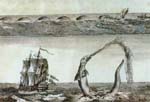 Engraving of XVIII century representing the sea snake.
Engraving of XVIII century representing the sea snake.
But the fearless traveller meets hidden dangers, as underwater stones under quiet surface of the sea: these are perfect creations with severe intentions. Myth about sirens is well known in various forms. In ancient Greek myths tell us about sirens who attract the attention of sailors and make them come to the places with underwater stones. They are winged creations with female heads. Scandinavian water-nymphs - halfly a woman and halfly a fish - rarely are dangerous
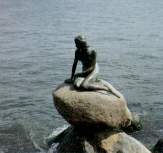
Copenhagen. One of the most famous sculptures of the world is "Water nymph,
the idea of which was given by the fairy tales of Andersen. During centuries people considered fantastic sea monsters as the reason of some ship-wrecks.
This being can even lose the immortality, by falling in love with man. But in the myths of Kelts the daughters of the sea - women of extraordinary beauty - leave sea, fascinate young men, and then take them away by the glass ship or take them into their remote islands or underwater palaces.

Kraken, huge octopus from the Scandinavian legends.
In Taiti a siren - daughter of a whale - is halfly a woman and halfly a fish in water; in the case of leaving water she becomes a young woman and too cares of her appearance... Myths about sirens have taken their places in the minds so that even Christopher Columbus insisted on having seen sirens. The great seafarer was disappointed: they have appeared not so charming, as he thought... It is rather probable, that these "sirens" were lamantins. They are nice sea animals, but they are not beautiful. Sea is a good place for adventures. However it always attracts imagination of people. What is there behind horizon? From immemorial times this question interested mankind that could find only one answer: to go towards to this disturbing uncertainty. The majority of myths of various peoples, telling about wonderful sea adventures proves it. Greek Odissey and Yuson , Irish Male-Dune, Brun from medieval novel, saint Brendon or viking Lafe Ericson sail, experience extraordinary adventures, make amazing discoveries. Behind sea unprecedented grounds lay: the paradise islands, where people do not know sorrow and are able only to laugh or to cry; horrible islands occupied by monsters or malicious spirits; the islands, where treasures are hidden. All these travels are not only the creatures of imagination. Quite often they are based on real facts, exaggerated or deformed. For example, saga about Lafe Ericson, telling about opening discovery of Greenland and Northern America by vikings in the fantastic form. Some details contained in "Odisseya", give the idea that its author had real knowledge of geography of Mediterranean. Therefore scientists have tried to designate a probable route of Odissey with book and maps in their hands... However, fantastic elements of 'sea' myths and legends are not to be considered as only the work of imagination. The desires and fears of people, their prejudices, their knowledge, their beliefs were reflected In them. By the way, improbable details exist even in those narrations, reliability of which is doubtless. So, Marco Polo during his long stay in China has made sea travel to Ceylon. And what has he seen there? Fantastic animal with one horn.He made Europeans belief in that animal.The modern reader will understand without any effort, that described animal was a simple rhinoceros. Columbus, who opened America had informed, that he saw improbable tree, on which sheet heads grow. It was treelike cotton plant, and the seafarer has described this plant with the help of habitual words and images. People thought that all is possible behind the seas. The sea travel quite often was represented as a travel to other world, the empire of dead people by ancient people. It is confirmed by Shumerian legend about navigation of Gilgamesh, and Kelt legends about paradise islands. In his travellings Greek Odissey and Anay from Troya find out an entrance in an underground empire, where Aid dominates, and go down there. Many sea peoples had a custom to put a body of the dead leader in the coffin in the form of boat. Such custom existed on all islands of Oceania, in Ancient Egypt, in Scandinavia. To die means to cross ocean, that is why any navigation was considered as travel to the world of dead people. In these beliefs the duality of sea was reflected: it is a source of life and the way to death, it creates and destroys. It is pleasant for modern to think that the ocean is tamed due to technical progress. Large ships plough a surface of the seas, the underwater devices are lowered to the bottom of the ocean. In good summer days the beaches become a favourite place of rest and entertainments. The fear of ancient people in the face of the ocean has disappeared today. We do not believe in god and pollute sea.. Though it is impossible to name our ships unsinkable at all, and the rest on the seashore requires care. A changeable surface of sea still has danger or secret in it. Ancient and modern myths remind us about that. Atlantida is a sunk continent, which was described by Platon in V century before our era, became a theme for set of the books and films in XX century . Secret of Bermud triangle is the remind about ancient myths about strange and inexplicable disappearances. So, the imagination of the man, both yesterday and today sees an element, to which his desires and alarms, his wish of adventures and dream of freedom are connected in the ocean.
Ship-phantom

 Engraving of XVIII century representing the sea snake.
Engraving of XVIII century representing the sea snake.

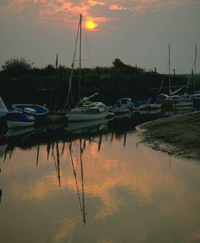 The ship with dead sailors travels around the seas. Sometimes during the storms it appeares, being impressive and frightening at the same time, before the amazed seamen of the ships, floating in the same waters. Such meeting can be a bad omen. This is the short retelling of the legend about the ship - phantom, which has appeared, probably, in Northern Europe. The most famous of them is "Flying Dutch". According to the legend, it ploughed the sea nearby to cape of Kind Hope. Edgar Po has devoted one of the chapters of his novel "The History Of Arthur Gordon Pim" to him and Rihard Wagner - an opera "Flying Dutch". Although this legend is only the creation of imagination, the ships - phantoms existed really. One of most known of them is "Mary Selest" - left by the sailors, was found out in 1872 between Azor islands and Gibraltar.
The ship with dead sailors travels around the seas. Sometimes during the storms it appeares, being impressive and frightening at the same time, before the amazed seamen of the ships, floating in the same waters. Such meeting can be a bad omen. This is the short retelling of the legend about the ship - phantom, which has appeared, probably, in Northern Europe. The most famous of them is "Flying Dutch". According to the legend, it ploughed the sea nearby to cape of Kind Hope. Edgar Po has devoted one of the chapters of his novel "The History Of Arthur Gordon Pim" to him and Rihard Wagner - an opera "Flying Dutch". Although this legend is only the creation of imagination, the ships - phantoms existed really. One of most known of them is "Mary Selest" - left by the sailors, was found out in 1872 between Azor islands and Gibraltar.



